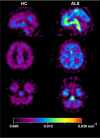PET imaging of reactive astrocytes in neurological disorders
- PMID: 34873637
- PMCID: PMC8921128
- DOI: 10.1007/s00259-021-05640-5
PET imaging of reactive astrocytes in neurological disorders
Abstract
The reactive astrocytes manifest molecular, structural, and functional remodeling in injury, infection, or diseases of the CNS, which play a critical role in the pathological mechanism of neurological diseases. A growing need exists for dependable approach to better characterize the activation of astrocyte in vivo. As an advanced molecular imaging technology, positron emission tomography (PET) has the potential for visualizing biological activities at the cellular levels. In the review, we summarized the PET visualization strategies for reactive astrocytes and discussed the applications of astrocyte PET imaging in neurological diseases. Future studies are needed to pay more attention to the development of specific imaging agents for astrocytes and further improve our exploration of reactive astrocytes in various diseases.
Keywords: Alzheimer’s disease (AD); Amyotrophic lateral sclerosis (ALS); Monoamine oxidases-B (MAO-B); Multiple sclerosis (MS); Parkinson’s disease (PD); Positron emission tomography (PET); Reactive astrocytes.
© 2021. The Author(s).
Conflict of interest statement
The authors declare no competing interests.
Figures





References
Publication types
MeSH terms
LinkOut - more resources
Full Text Sources
Medical
Research Materials
Miscellaneous

